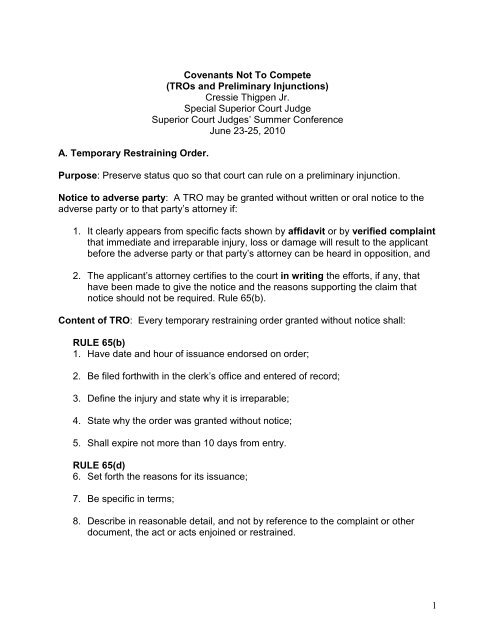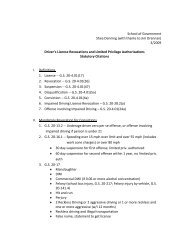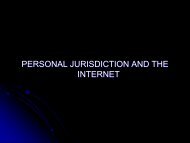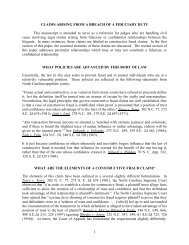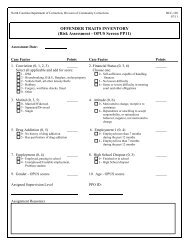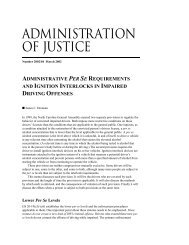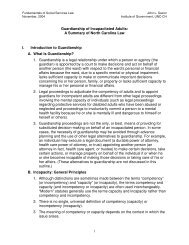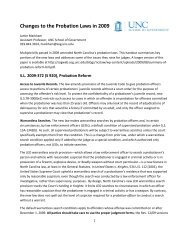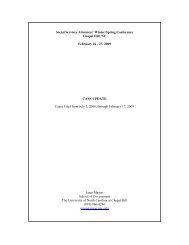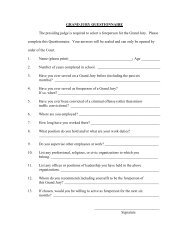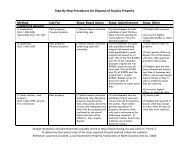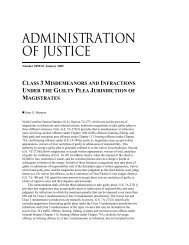Covenants Not to Compete (TROs and Preliminary Injunctions
Covenants Not to Compete (TROs and Preliminary Injunctions
Covenants Not to Compete (TROs and Preliminary Injunctions
Create successful ePaper yourself
Turn your PDF publications into a flip-book with our unique Google optimized e-Paper software.
A. Temporary Restraining Order.<br />
<strong>Covenants</strong> <strong>Not</strong> To <strong>Compete</strong><br />
(<strong>TROs</strong> <strong>and</strong> <strong>Preliminary</strong> <strong>Injunctions</strong>)<br />
Cressie Thigpen Jr.<br />
Special Superior Court Judge<br />
Superior Court Judges’ Summer Conference<br />
June 23-25, 2010<br />
Purpose: Preserve status quo so that court can rule on a preliminary injunction.<br />
<strong>Not</strong>ice <strong>to</strong> adverse party: A TRO may be granted without written or oral notice <strong>to</strong> the<br />
adverse party or <strong>to</strong> that party’s at<strong>to</strong>rney if:<br />
1. It clearly appears from specific facts shown by affidavit or by verified complaint<br />
that immediate <strong>and</strong> irreparable injury, loss or damage will result <strong>to</strong> the applicant<br />
before the adverse party or that party’s at<strong>to</strong>rney can be heard in opposition, <strong>and</strong><br />
2. The applicant’s at<strong>to</strong>rney certifies <strong>to</strong> the court in writing the efforts, if any, that<br />
have been made <strong>to</strong> give the notice <strong>and</strong> the reasons supporting the claim that<br />
notice should not be required. Rule 65(b).<br />
Content of TRO: Every temporary restraining order granted without notice shall:<br />
RULE 65(b)<br />
1. Have date <strong>and</strong> hour of issuance endorsed on order;<br />
2. Be filed forthwith in the clerk’s office <strong>and</strong> entered of record;<br />
3. Define the injury <strong>and</strong> state why it is irreparable;<br />
4. State why the order was granted without notice;<br />
5. Shall expire not more than 10 days from entry.<br />
RULE 65(d)<br />
6. Set forth the reasons for its issuance;<br />
7. Be specific in terms;<br />
8. Describe in reasonable detail, <strong>and</strong> not by reference <strong>to</strong> the complaint or other<br />
document, the act or acts enjoined or restrained.<br />
1
Duration:<br />
1. No more than 10 days from entry.<br />
2. May be extended for one additional 10 day period if applicant makes request for<br />
extension within original 10-day period <strong>and</strong> shows good cause for extension.<br />
Reasons for granting any extension must be entered of record. May also be<br />
extended with consent of enjoined party. Rule 65(b).<br />
Security. No restraining order or preliminary injunction shall issue except upon the<br />
giving of security by the applicant, in such sum as the judge deems proper, for the<br />
payment of such costs <strong>and</strong> damages as may be incurred or suffered by any party who is<br />
found <strong>to</strong> have been wrongfully enjoined or restrained. Rule 65(c).<br />
The trial court has power not only <strong>to</strong> set the amount of security but <strong>to</strong> dispense<br />
with any security requirement whatsoever where the restraint will do the<br />
defendant no material damage, where there has been no proof of likelihood of<br />
harm <strong>and</strong> where the applicant for equitable relief has considerable assets <strong>and</strong> is<br />
able <strong>to</strong> respond in damages if defendant does suffer damages by reason of a<br />
wrongful injunction. Keith v. Day, 60 N.C. App. 559, 299 S.E.2d 296 (1983)<br />
(quoting Federal Prescription Service, Inc. et al. v. American Pharmaceutical<br />
Assoc., 636 F. 2d 755, 759 (D.C. Cir. 1980)). However, “any order that precludes<br />
one from earning a livelihood <strong>and</strong> that has the potential <strong>to</strong> destroy that person’s<br />
means of income production for years <strong>to</strong> come is <strong>to</strong>o potent <strong>to</strong> issue without<br />
security.” Id.<br />
2
B. <strong>Preliminary</strong> <strong>Injunctions</strong>.<br />
Purpose: Preserve the status quo until a trial on the merits. See Lambe v. Smith, 11<br />
N.C. App. 580, 582, 181 S.E.2d 783,784 (1971).<br />
Burden of proof: At hearing on preliminary injunction, the party who obtained the TRO<br />
must go forward with request for preliminary injunction, or court must dissolve the TRO.<br />
Rule 65(b). See Pruitt v. Williams, 288 N.C. 368, 218 S.E.2d 348 (1975).<br />
<strong>Not</strong>ice <strong>to</strong> adverse party. No preliminary injunction shall be issued without notice <strong>to</strong> the<br />
adverse party. Rule 65(a). “<strong>Not</strong>ice” is not defined. However, a preliminary injunction<br />
can only be issued after notice <strong>and</strong> a hearing, which affords the adverse party an<br />
opportunity <strong>to</strong> present evidence in his behalf. Lambe v. Smith, 11 N.C. App. 580, 181<br />
S.E.2d 783 (1971). A preliminary injunction entered without notice affects a “substantial<br />
right” <strong>and</strong> is immediately appealable. See Perry v. Baxley Development, Inc. 188 N.C.<br />
App. 158, 655 S.E.2d 460 (2008).<br />
Interaction with Rule 6(d). Rule 6(d) requires 5 days notice before hearing on a<br />
motion. Also requires that affidavits be served with the motion. Formal compliance with<br />
6(d) may not be necessary if opposing party has adequate notice <strong>to</strong> allow preparation of<br />
a defense.<br />
Grounds for granting motion for preliminary injunction.<br />
1. A preliminary injunction is an extraordinary measure taken by a court <strong>to</strong> preserve<br />
the status quo of the parties during litigation. It will be issued only (1) If plaintiff is<br />
able <strong>to</strong> show the likelihood of success on the merits of his case <strong>and</strong> (2) if plaintiff<br />
is likely <strong>to</strong> sustain irreparable loss unless the injunction is issued, or if, in the<br />
opinion of the court, issuance is necessary for the protection of plaintiff’s rights<br />
during the course of litigation. See A.E.P. Indus., Inc. v. McClure, 308 N.C. 393,<br />
302 S.E.2d 754 (1983); Waff Bros., Inc. v. Bank, 289 N.C. 198, 221 S.E. 2d 273<br />
Triangle Leasing Company, Inc. v. McMahon,327 N.C. 224, 393 S.E.2d 854<br />
(1990).<br />
2. To establish a likelihood of success on the merits, the employer must make a<br />
prima facie showing that the covenant is valid <strong>and</strong> enforceable against the<br />
employee. NovaCare Orthotics & Prosthetics East, Inc. v. Speelman, 137 N.C.<br />
App. 471, 528 S.E.2d 918 (2000).<br />
3
C. Applying the requirements of Rule 65 <strong>to</strong> covenant not <strong>to</strong> compete cases.<br />
Requirement that plaintiff show likelihood of success on the merits of the case.<br />
1. “Where a preliminary injunction is sought <strong>to</strong> enforce a non-competition clause in<br />
an employment contract, the Supreme Court has held that the employment<br />
agreement itself must be valid <strong>and</strong> enforceable in order for the employer <strong>to</strong> be<br />
able <strong>to</strong> show the requisite likelihood of success on the merits”. Triangle Leasing<br />
Co. v. McMahon, 327 N.C. 224, 227-28, 393 S.E.2d 854, 857 (1990) (citing<br />
A.E.P. Industries, 308 N.C. 393, 302 S.E.2d 754).<br />
2. A covenant in an employment agreement providing that an employee will not<br />
compete with his former employer is “not viewed favorably in modern law”.<br />
Hartman v. W.H.Odell & Assocs., 117 N. C. App. 307, 311, 450 S.E.2d 912, 916<br />
(1994).<br />
3. A covenant not <strong>to</strong> compete is enforceable if it is: (1) in writing, (2) made part of a<br />
contract of employment; (3) based on valuable consideration; (4) reasonable<br />
both as <strong>to</strong> time <strong>and</strong> terri<strong>to</strong>ry; <strong>and</strong> (5) not against public policy. Triangle Leasing<br />
Co., Inc. v. McMahon, 327 N.C. 224, 228, 393 S.E.2d 854, 857 (1990); Moses H.<br />
Cone Mem’l Health Servs. Corp. v. Triplett, 167 N.C. App. 267, 605 S.E.2d 492,<br />
497 (2004).<br />
a. Requirement that the covenant be in writing. If covenant was a part of<br />
original, oral contract of employment, it was founded on valuable<br />
consideration even though covenant was not put in<strong>to</strong> writing <strong>and</strong> signed until<br />
after defendant started work. See Robins & Weill,Inc. v. Mason, 70 N.C.App.<br />
537, 320 S.E.2d 693 (1984). In addition <strong>to</strong> being in writing the covenant must<br />
be signed by the one who agrees not <strong>to</strong> compete. See G.S.75-4.<br />
b. Requirement that agreement be part of contract of employment. Some<br />
cases suggest that covenant must be entered in<strong>to</strong> as part of “original contract<br />
of employment.” See New Hanover Rent-A-Car, Inc. v. Martinez, 136 N.C.<br />
App. 642, 644, 525 S.E.2d 487 (2000). However, if covenant was part of<br />
original, oral contract of employment <strong>and</strong> was supported by consideration, it<br />
was enforceable even though not put in<strong>to</strong> writing <strong>and</strong> signed until after<br />
defendant started work. See Robins & Weill, Inc. v. Mason, 70 N.C. App.<br />
537, 320 S.E.2d 693 (1984).<br />
c. Requirement that agreement be supported by consideration. Where the<br />
covenant is entered in<strong>to</strong> in connection with an employee’s being hired for a<br />
job, it is generally held that mutual promises of employer <strong>and</strong> employee<br />
furnish valuable considerations each <strong>to</strong> the other for the contract. Hejl v.<br />
Hood, Hargett & Assoc., 674 S.E.2d 425, 2009 N.C. App. Lexis 377, (2009)<br />
citing Reynolds & Reynolds Co. v. Tart, 955 F. Supp 547, 553 (W.D.N.C.)<br />
4
(quoting Greene Co. v. Kelley, 261 N.C. 166, 168, 134 S.E.2d 166, 167<br />
(1964). However, when the restrictive covenant is entered in<strong>to</strong> after an<br />
already existing employment relationship, the covenant must be supported by<br />
“new consideration.” Greene Co., 261 N.C. at 168, 134 S.E.2d at 167.<br />
Our courts have held the following benefits all meet the “new” or<br />
“separate” consideration required for a non-compete agreement entered<br />
in<strong>to</strong> after a working relationship already exists:<br />
� continued employment for a stipulated amount of time, Amdar, Inc.<br />
v. Satterwhite, 37 N.C. App. 410, 246 S.E.2d 165, disc. Review<br />
denied, 295 N.C. 645, 248 S.E.2d 249 (1978);<br />
� a raise, bonus, or other change in compensation, Clyde Rudd &<br />
Associates, Inc. v. Taylor, 29 N.C. App. 679, 225 S.E.2d 602<br />
(1976); a promotion, Associates, Inc. v. Taylor, 29 N.C. App. 679,<br />
225 S.E.2d 602 (1876);<br />
� additional training, Safety Equipment Sales & Service, Inc. v.<br />
Williams, 22 N.C. App. 410, 206 S.E.2d 745 (1974); uncertificated<br />
shares, Kinesis Adver., Inc. v. Hill, 187 N.C. App. 1, 652 S.E.2d 284<br />
(2007);<br />
� or some other increase in responsibility or number of hours worked,<br />
Whittaker Gen. Med. Corp. v. Daniel, 324 N.C. 523, 379 S.E.2d 824<br />
(1989).<br />
� “The slightest consideration is sufficient <strong>to</strong> support the most<br />
onerous obligation, the inadequacy… is for the parties <strong>to</strong> consider<br />
at the time of making the agreement, <strong>and</strong> not for the court when it is<br />
sought <strong>to</strong> be enforced. Catawba Valley Machinery Co. v. Insurance<br />
Co., 13 N.C. App. 85, 90-91, 185 S.E.2d 308, 311-12 (1971)<br />
(quoting Young v. Highway Commission, 190 N.C. 52, 57, 128 S.E.<br />
401, 403 (1925), cert denied, 280 N.C. 302, 186 S.E.2d 176 (1972).<br />
d. Requirement that covenant be reasonable as <strong>to</strong> time <strong>and</strong> terri<strong>to</strong>ry.<br />
• Time. “A five-year time restriction is the outer boundary which our<br />
courts have considered reasonable, <strong>and</strong> even so, five-year restrictions<br />
are not favored.” Farr Assocs., 138 N.C. App. At 280, 530 S.E. 2d at<br />
881. See Welcome Wagon, Inc. v. Pender, 255 N.C. 244, 120 S.E.2d<br />
739 (1961). See also Kennedy v. Kennedy,160 N.C. App. 1, 584<br />
S.E.2d 328 (2002) (enforcing covenant for a period of 3 years);<br />
Precision Walls, Inc. v. Servie, 152 N.C. App. 630, 568 S.E.2d 267<br />
(2002) (enforcing 1 year covenant); Triangle Leasing Co., v. McMahon,<br />
327 N.C. 224, 393 S.E.2d 854 (1990)(upholding 2 year restriction).<br />
5
When a non-compete reaches back <strong>to</strong> include clients of the employer<br />
during some period in the past, that look-back period must be added <strong>to</strong><br />
the restrictive period <strong>to</strong> determine the real scope of the time limitation.<br />
Farr Assocs. at 280, 530 S.E.2d at 881.<br />
• Terri<strong>to</strong>ry. “A restriction as <strong>to</strong> terri<strong>to</strong>ry is reasonable only <strong>to</strong> the extent it<br />
protects the legitimate interests of the employer in maintaining [its]<br />
cus<strong>to</strong>mers.” Manpower, Inc. v. Hedgecock, 42 N.C. App. 515, 523, 257<br />
S.E.2d 109, 115 (1979).<br />
“To prove that a geographic restriction in a covenant not <strong>to</strong> compete is<br />
reasonable, an employer must first show where its cus<strong>to</strong>mers are located<br />
<strong>and</strong> that the geographic scope of the covenant is necessary <strong>to</strong> maintain<br />
those cus<strong>to</strong>mer relationships.” Hartman v. Odell <strong>and</strong> Assoc., Inc., 117<br />
N.C. App. 307, 312, 450 S.E.2d 912, 917 (1994), disc. review denied, 339<br />
N.C.612, 454 S.E. 2d 251 (1995).<br />
“The terri<strong>to</strong>ry embrace[d] [by the covenant] shall be no greater than is<br />
reasonably necessary <strong>to</strong> secure the protection of the business or good will<br />
of the employer.” A.E.P. Industries v. McClure, 308 N.C. 393, 408, 302<br />
S.E.2d 754, 763 (1983) (quoting Asheville Associates v. Miller <strong>and</strong><br />
Asheville Associates v. Berman, 255 N.C. 400, 404, 121 S.E.2d 593, 595<br />
(1961).<br />
Fac<strong>to</strong>rs <strong>to</strong> determine in deciding whether geographic scope of restriction is<br />
reasonable include (1) area or scope of restriction, (2) area assigned <strong>to</strong><br />
employee, (3) area in which employee actually worked, (4) area in which<br />
employer operated, (5) nature of business involved, <strong>and</strong> (6) nature of<br />
employee’s duty <strong>and</strong> his knowledge of business operation. Farr Assocs.,<br />
138 N.C. App. 276, 530 S.E.2d 878 (2000). See also Visionair, Inc. v.<br />
James, 167 N.C. App. 504, 606 S.E.2d 359 (2004) (holding covenant<br />
providing that employee could not compete with employer within the<br />
Southeast was overbroad <strong>and</strong> unenforceable); Masterclean of North<br />
Carolina, Inc. v. Guy, 82 N.C. App. 45, 345 S.E.2d 692 (1986)(refusing <strong>to</strong><br />
enforce covenant that prohibited former employee from competing<br />
anywhere in the United States); Starkings Court Reporting Services, Inc.<br />
v. Collins, 67 N.C. App. 540, 313 S.E.2d 614 (1984) (declining <strong>to</strong> enforce<br />
covenant prohibiting reporter from engaging in court reporting within 50<br />
miles of county).<br />
Restrictions barring an employee from working in an identical position for<br />
a direct competi<strong>to</strong>r are valid <strong>and</strong> enforceable. Precision Walls Inc., v.<br />
Servie, 152 N.C. App. 630, 568 S.E.2d 267 (2002). However, restrictive<br />
covenants are unenforceable where they prohibit the employee from<br />
engaging in future work that is distinct from the duties actually performed<br />
6
y the employee. Henley Paper Co. v. McAllister, 253 N.C.529, 117<br />
S.E.2d 431 (1960).<br />
The time <strong>and</strong> geographic limitations of a covenant not <strong>to</strong> compete must be<br />
considered in t<strong>and</strong>em, such that “[a] longer period of time is acceptable<br />
where the geographic restriction is relatively small, <strong>and</strong> vice versa.” Farr<br />
Associates Inc. v. Baskin, 138 N.C. App. at 280, 530 S.E.2d at 881 (citing<br />
Jewel Box S<strong>to</strong>res Corp. v. Morrow, 272 N. C. 659, 158 S.E.2d 840<br />
(1968)).<br />
e. Requirement that covenant not contravene public policy. Distinction is<br />
between whether there will be an inconvenience <strong>to</strong> the public or whether<br />
there will be a substantial question of potential harm. For covenants not <strong>to</strong><br />
compete concerning doc<strong>to</strong>rs see Iredell Digestive Disease Clinic v. Petrozza,<br />
92 N.C. App. 21, 24, 373 S.E. 2d 449, 451 (1988), affirmed, 324 N.C. 327,<br />
377 S.E. 2d 750 (1989), where the court stated “A covenant not <strong>to</strong> compete<br />
between physicians is not contrary <strong>to</strong> public policy if it is intended <strong>to</strong> protect a<br />
legitimate interest of the covenantee <strong>and</strong> is not so broad as <strong>to</strong> be oppressive<br />
<strong>to</strong> the covenan<strong>to</strong>r or the public…If ordering the covenan<strong>to</strong>r <strong>to</strong> honor his<br />
contractual obligation would create a substantial question of potential harm <strong>to</strong><br />
the public health, then the public interests outweigh the contract interests of<br />
the covenantee, <strong>and</strong> the court will refuse <strong>to</strong> enforce the covenant…But if<br />
ordering the covenan<strong>to</strong>r <strong>to</strong> honor his agreement will merely inconvenience the<br />
public without causing substantial harm, then the covenantee is entitled <strong>to</strong><br />
have his contract enforced”. See also Kennedy v. Kennedy, 160 N.C. App. 1,<br />
584 S.E.2d 328 (2003).<br />
In order <strong>to</strong> determine whether there is a substantial question of potential harm<br />
<strong>to</strong> the public health, the court will examine: (1) the shortage of specialists in<br />
the field in the restricted area; (2) whether the enforcement of the covenant<br />
creates a monopoly in that specialty area; <strong>and</strong> (3) the patients’ interest in<br />
having a choice in the selection of a physician. Statesville Medical Group v.<br />
Dickey, 106 N.C. App. 669, 673, 418 S.E.2d 256, 259, review denied, 333 N.<br />
C. 257, 424 S.E.2d 922 (1992).<br />
The “public policy” requirement has also been used interchangeably with<br />
whether the covenant protects a “legitimate business interest” of the<br />
employer. Professional Liability Consultants, Inc. v. Todd, 122 N.C. App. 212,<br />
218, 468 S. E. 2d 578, 582 (1996); Hartman v. Odell & Assocs., Inc., 117 N.<br />
C. App. 307, 311, 450 S. E. 2d 912, 916 (1994).<br />
7
Plaintiff is likely <strong>to</strong> suffer irreparable loss unless the injunction is issued, or if, in<br />
the opinion of the court, issuance is necessary for the protection of plaintiff’s<br />
rights during the course of litigation.<br />
1. Our courts have held that intimate knowledge of the business operations or<br />
personal association with cus<strong>to</strong>mers provides an opportunity <strong>to</strong> a former<br />
employee <strong>to</strong> injure the business of the covenantee. See United Labraories, Inc.<br />
v. Kuykendall, 322 N.C. 643, 370 S.E.2d 375 (1988).<br />
2. In A.E.P. Industries, v. McClure, 308 N.C. 393, 302 S.E.2d 754 (1983) the North<br />
Carolina Supreme Court accepted plaintiff’s argument that:<br />
“[in a] noncompetition agreement, breach is the controlling fac<strong>to</strong>r <strong>and</strong><br />
injunctive relief follows almost as a matter of course; damage from the<br />
breach is presumed <strong>to</strong> be irreparable <strong>and</strong> the remedy at law is<br />
considered inadequate. It is not necessary <strong>to</strong> show actual damage by<br />
instances of successful competition, but it is sufficient if such<br />
competition, in violation of the covenant, may result in injury.”<br />
The court consequently held that “[w]here the primary ultimate remedy<br />
sought is an injunction; where the denial of a preliminary injunction<br />
would serve effectively <strong>to</strong> foreclose adequate relief <strong>to</strong> plaintiff; where no<br />
“legal” (as opposed <strong>to</strong> equitable) remedy will suffice; <strong>and</strong> where the<br />
decision <strong>to</strong> grant or deny a preliminary injunction in effect results in a<br />
determination on the merits, plaintiff has made a showing that the<br />
issuance of a preliminary injunction is necessary for the protection of its<br />
rights during the course of litigation”. Id. at 410, 302 S.E.2d at 764.<br />
8
D. Issuance of preliminary injunction.<br />
1. Similar <strong>to</strong> the order granting the TRO, the order granting the preliminary<br />
injunction shall (1) set forth the reasons for its issuance; (2) shall be specific in<br />
terms; <strong>and</strong> (3) shall describe in reasonable detail, <strong>and</strong> not by reference <strong>to</strong> the<br />
complaint or other document, the act or acts enjoined or restrained. Rule 65(d).<br />
2. Interaction with Rule 52(a)(2). Findings of fact <strong>and</strong> conclusions of law are<br />
necessary on the granting or denying of a preliminary injunction or any other<br />
provisional remedy only when required by statute expressly relating <strong>to</strong> such<br />
remedy or requested by a party. Rule 52(a) (2). Absence a request by a party<br />
that the court make findings of fact <strong>and</strong> conclusions of law, the court is required<br />
<strong>to</strong> state only the reasons for its issuance. See Pruitt v. Williams, 25 N.C. App.<br />
376, 213 S.E.2d 369 (1975).<br />
3. The injunction is binding only upon the parties <strong>to</strong> the action, their officers,<br />
agents, servants, employees <strong>and</strong> at<strong>to</strong>rneys, <strong>and</strong> upon those persons in active<br />
concert or participation with them who receive actual notice in any manner of the<br />
order by personal service or otherwise. Rule 65(d).<br />
4. Security. No restraining order or preliminary injunction shall issue except upn the<br />
giving of security by the applicant, in such term as the judge deems proper,<br />
for the payment of such costs <strong>and</strong> damages as may be incurred or suffered by<br />
any party who is found <strong>to</strong> have been wrongfully enjoined or restrained. Rule<br />
65(c).<br />
The trial court has power not only <strong>to</strong> set the amount of security but <strong>to</strong> dispense<br />
with any security requirement whatsoever where the restraint will do the<br />
defendant no material damage, where there has been no proof of likelihood of<br />
harm <strong>and</strong> where the applicant for equitable relief has considerable assets <strong>and</strong> is<br />
able <strong>to</strong> respond in damages if defendant does suffer damages by reason of a<br />
wrongful injunction. Keith v. Day, 60 N.C. App. 559, 299 S.E.2d 296 (1983)<br />
(quoting Federal Prescription Service, Inc. et al. v. American Pharmaceutical<br />
Assoc., 636 F. 2d 755, 759 (D.C. Cir. 1980)). However, “any order that precludes<br />
one from earning a livelihood <strong>and</strong> that has the potential <strong>to</strong> destroy that person’s<br />
means of income production for years <strong>to</strong> come is <strong>to</strong>o potent <strong>to</strong> issue without<br />
security.” Id. For examples of cases in which a bond was set see Barr-Mullin,<br />
Inc. v. Browning, 108 N.C. App. 590, 424 S.E.2d 226 (1993)(trial court required<br />
$10,000 bond for injunction barring former employee <strong>and</strong> his new company from<br />
marketing software); Curtis1000, Inc. v. Youngblade, 878 F. Supp. 1224 (D.<br />
Iowa 1995)(bond of $200,000 for preliminary injunction enjoining salesperson<br />
from violating covenant not <strong>to</strong> compete); St<strong>and</strong>ard Register Co. v. Cleaver, 30 F.<br />
Supp. 2d 1084 (D. Ind. 1998)(requiring $150,000 bond for preliminary<br />
injunction).<br />
9
“Wrongfully enjoined or restrained” means:<br />
o Final adjudication substantially favorable <strong>to</strong> the defendant on the merits of<br />
plaintiff’s claim. See Industrial Innova<strong>to</strong>rs, Inc. v. Myrick-White, 99 N.C.<br />
App. 42, 392 S.E.2d 425 (1990); or<br />
o Final adjudication that does not address the merits-e.g., on jurisdictional<br />
grounds-if the defendant also shows that he or she was entitled <strong>to</strong> engage<br />
in the enjoined activity, see id; or<br />
o Voluntary dismissal (by stipulation of parties). See id.<br />
5. No security required of State of N.C., or its counties or municipalities or officers<br />
or agencies acting in official capacity. Damages may be awarded against these<br />
parties. Rule 6(c).<br />
6. Surety submits <strong>to</strong> court’s jurisdiction of the court <strong>and</strong> irrevocably appoints clerk<br />
of court as agent for service of process. Rule 65(c).<br />
7. Liability may be enforced upon motion (served on clerk) or by independent<br />
action. Rule 65(c).<br />
8. Wrongfully enjoined or restrained party may seek damages against party that<br />
procured the injunction <strong>and</strong> the surety by motion. No need <strong>to</strong> show malice or<br />
lack of probable cause if proceeding by motion. No right <strong>to</strong> jury trial if matter<br />
heard upon motion.<br />
E. Prohibi<strong>to</strong>ry <strong>and</strong> M<strong>and</strong>a<strong>to</strong>ry <strong>Injunctions</strong>.<br />
<strong>Injunctions</strong> may be classified as “prohibi<strong>to</strong>ry” <strong>and</strong> “m<strong>and</strong>a<strong>to</strong>ry”. The former are<br />
preventive in character, <strong>and</strong> forbid the continuance of a wrongful act or the doing of<br />
some threatened or anticipated injury; the latter are affirmative in character, <strong>and</strong> require<br />
positive action involving a change of existing conditions—the doing or undoing of an act.<br />
Roberts v.Madison County Real<strong>to</strong>rs Association, Inc., 344 N.C. 394, 474 S.E.2d 783<br />
(1996) citing 42 Am. Jur. 2d <strong>Injunctions</strong> §9 (1969); accord Seaboard Air Line R.R. Co. v.<br />
Atlantic Coast Line R.R., 237 N.C. 88, 94, 74 S.E.2d 430, 434 (1953).<br />
M<strong>and</strong>a<strong>to</strong>ry injunctions are disfavored as an interlocu<strong>to</strong>ry remedy. “As a general rule,<br />
since the purpose of an interlocu<strong>to</strong>ry injunction is solely <strong>to</strong> retain the status quo<br />
[pending final resolution on the merits], only a prohibi<strong>to</strong>ry injunction is proper [as<br />
opposed <strong>to</strong> a m<strong>and</strong>a<strong>to</strong>ry injunction, which would alter the status quo]. Roberts v.<br />
Madison citing John F. Dobbyn, <strong>Injunctions</strong> In a Nutshell 163 (1974). However, in<br />
Roberts the court went on <strong>to</strong> say that “[H]owever, we note that under circumstances<br />
which indicate ‘serious irreparable injury <strong>to</strong> the petitioner if the injunction is not granted,<br />
10
no substantial injury <strong>to</strong> the respondent if the injunction is granted, <strong>and</strong> predictably good<br />
chances of success on the final decree by the petitioner, a m<strong>and</strong>a<strong>to</strong>ry interlocu<strong>to</strong>ry<br />
injunction could properly be issued.’” Citing Dobbyn at 167-68.<br />
F. Rewriting unenforceable covenant not <strong>to</strong> compete.<br />
When the language of a covenant not <strong>to</strong> compete is overly broad, North Carolina's "blue<br />
pencil” rule severely limits what the court may do <strong>to</strong> alter the covenant. A court at most<br />
may choose not <strong>to</strong> enforce a distinctly separable part of a covenant in order <strong>to</strong> render<br />
the provision reasonable. It may not otherwise revise or rewrite the covenant. Hartman<br />
v. W.H. Odell <strong>and</strong> Associates, Inc. 117 N.C. App. 307, 450 S.E.2d 912 (1994). If a noncompete<br />
covenant "is <strong>to</strong>o broad <strong>to</strong> be a reasonable protection <strong>to</strong> the employer's<br />
business it will not be enforced. The courts will not rewrite a contract if it is <strong>to</strong>o broad but<br />
will simply not enforce it." Whittaker General Medical Corporation v. Daniel, 324 N.C.<br />
523, 528, 379 S.E.2d 824, 828 (1989).<br />
11
G. Appeal of order granting/denying motion for preliminary injunction.<br />
Appeal of a trial court’s ruling on a motion for preliminary injunction is interlocu<strong>to</strong>ry. For<br />
appellate review <strong>to</strong> be appropriate, the trial court’s ruling must have deprived the<br />
appellant of a substantial right that will be lost absent review before final disposition of<br />
the case. N.C.G.S. §1- 277, 7A-27. In cases involving an alleged breach of a noncompetition<br />
agreement <strong>and</strong> an agreement prohibiting disclosure of confidential<br />
information, North Carolina appellate courts have routinely reviewed interlocu<strong>to</strong>ry court<br />
orders both granting <strong>and</strong> denying preliminary injunctions, holding that substantial rights<br />
have been affected. See, QSP, Inc., v. Hair, 152 N.C. App. 174, 566 S.E.2d 851 (2002).<br />
On appellate review of a preliminary injunction, the court is not bound by the trial court’s<br />
findings of fact. Rather, the appellate court reviews the evidence de novo <strong>and</strong> makes its<br />
own findings of fact <strong>and</strong> conclusions of law. Szymczyk v. Signs Now Corp., 168<br />
N.C.App. 182, 606 S.E.2d 728 (2005). Nevertheless, a trial court’s ruling on a motion for<br />
a preliminary injunction is presumed <strong>to</strong> be correct, <strong>and</strong> the party challenging the ruling<br />
bears the burden of showing it was erroneous. Analog Devices, Inc. v. Michalski, 157<br />
N.C.App. 462, 579 S.E.2d 449 (2003).<br />
12


